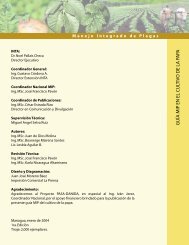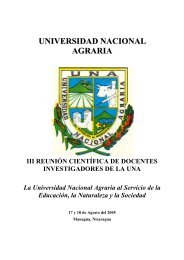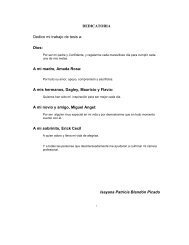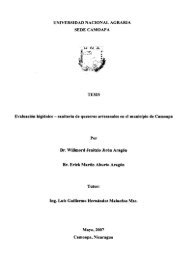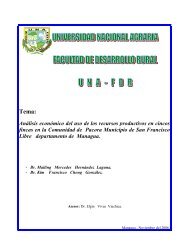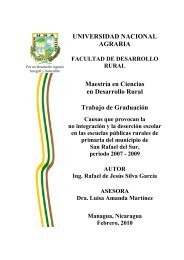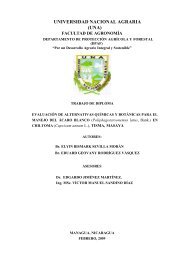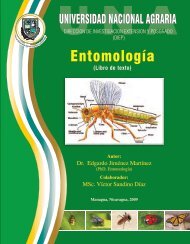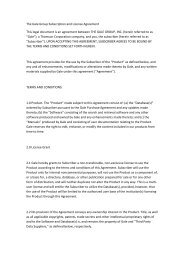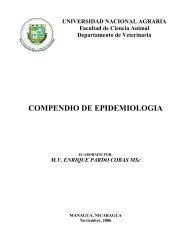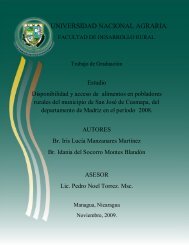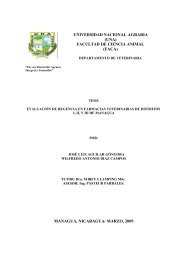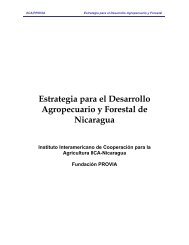LA CALERA - Universidad Nacional Agraria
LA CALERA - Universidad Nacional Agraria
LA CALERA - Universidad Nacional Agraria
Create successful ePaper yourself
Turn your PDF publications into a flip-book with our unique Google optimized e-Paper software.
<strong>LA</strong> <strong>CALERA</strong> BOSQUES Y ECOSISTEMAS UNA<br />
TRATAMIENTO SILVICULTURAL, MONITOREO Y REPOB<strong>LA</strong>CIÓN<br />
CON IGUANA (Iguana iguana) EN BOSQUE DE GALERÍA DE <strong>LA</strong> UNIDAD<br />
PRODUCTIVA HACIENDA <strong>LA</strong>S MERCEDES SUR DEL <strong>LA</strong>GO XOLOT<strong>LA</strong>N<br />
Emelina Tapia 1 , Francisco Reyes 1 , Karen Vindell 2 , Belkys Hernández 2<br />
1 Ing.Agrónomo Forestal. Docentes investigadores Departamento de manejo de Bosque y Ecosistemas, FARENA, UNA. Apdo 453.<br />
2 Graduadas de la carrera de Ingeniería Forestal. FARENA/UNA.<br />
RESUMEN<br />
El estudio fue realizado en la Unidad Productiva “Hacienda<br />
Las Mercedes” patrimonio de la <strong>Universidad</strong> <strong>Nacional</strong><br />
<strong>Agraria</strong> (UNA). El objetivo fue contribuir a la conservación<br />
del Bosque de Galería mediante la aplicación del tratamiento<br />
silvicultural de enriquecimiento y repoblación con la especie<br />
Iguana iguana. La metodología se desarrolló iniciando con una<br />
visita de reconocimiento a La ribera de la Presa Los Sábalos<br />
(sitio de la plantación forestal) y a la ribera Presa Las Mercedes<br />
(sitio para la repoblación con iguanas). El experimento de<br />
de repoblación forestal inició con el establecimiento de seis<br />
parcelas con especies forestales (Pithecellobium saman (jacq)<br />
Bent, Swietenia humilis Zucc, Guazuma ulmifolia Lam,<br />
Calycophyllum candidissimum (Vahl) DC, Albizzia caribeae<br />
(Urb).B&R y Dalbergia retusa Hemsl) en un área de 0.22 ha.<br />
Dentro de cada parcela se ubicó una parcela útil (16 individuos)<br />
para realizar el levantamiento de datos dasométricos (altura<br />
cm, diámetro basal mm y sobrevivencia) y análisis estadístico.<br />
Luego se identificaron las especies vegetales presentes en<br />
la plantación y se monitoreo (caracterización del sitio) de<br />
Iguana iguana (Iguana verde) y Ctenosaura similis (Garrobo<br />
negro también conocida como iguana rayada), para lo cual<br />
se establecieron seis transeptos (156 m, 200 m, 209 m, 212<br />
m, 190 m y 198 m) en 4.9 ha con la aplicación del método<br />
de King. Posteriormente se estableció la repoblación con la<br />
especie Iguana iguana; para ello se introdujeron 18 hembras y<br />
6 machos. Por último se realizo el procesamiento y análisis de<br />
ABSTRACT<br />
This study was carried out at Las Mercedes farm, National<br />
<strong>Agraria</strong>n University. The objective was to contribute to the<br />
conservation of the gallery forest with the establishment<br />
of forest plantation and repopulation of iguanas. The<br />
methodological process started with visits to the two<br />
selected sites: Sábalos River (where the forest plantation was<br />
established) and Las Mercedes River (repopulation of iguanas<br />
experiment). Initially, six plots with selected forest species<br />
were established in an area of 0.22 ha. The species were:<br />
(Pithecellobium saman (Jacq) Bent, Swietenia humilis Zucc,<br />
Guazuma ulmifolia Lam, Calycophyllum candidissimum<br />
(Vahl) AD, Albizzia caribeae (Urb). B&R, Dalbergia retusa<br />
Hemsl). The data collected include variable such as height<br />
(cm), basal diameter (mm) and survival. To perform the<br />
statistical analysis, 16 individuals in each plot were selected,<br />
followed by identification of the vegetation present in the<br />
forest plantation. In order to monitor (site characterization)<br />
Iguana iguana (green Iguana ) and Ctenosaura similis (Garrobo<br />
negro) six transepts were used (156 m, 200 m, 209 m, 212<br />
m, 190 m and 198 m respectively) in an area of 4.9 ha, using<br />
the King method. The next step was the repopulation with<br />
Iguana iguana (18 females and 6 males). Data collected were<br />
processed and analyzed. The highest increment in height and<br />
basal diameter were obtained by C candidissimum (21.93 and<br />
3.655 cm and 0.34 and 0.057 mm). Excellent (100%) survival<br />
values were obtained for C. candidissimum (Vahl) AD and D.<br />
21



